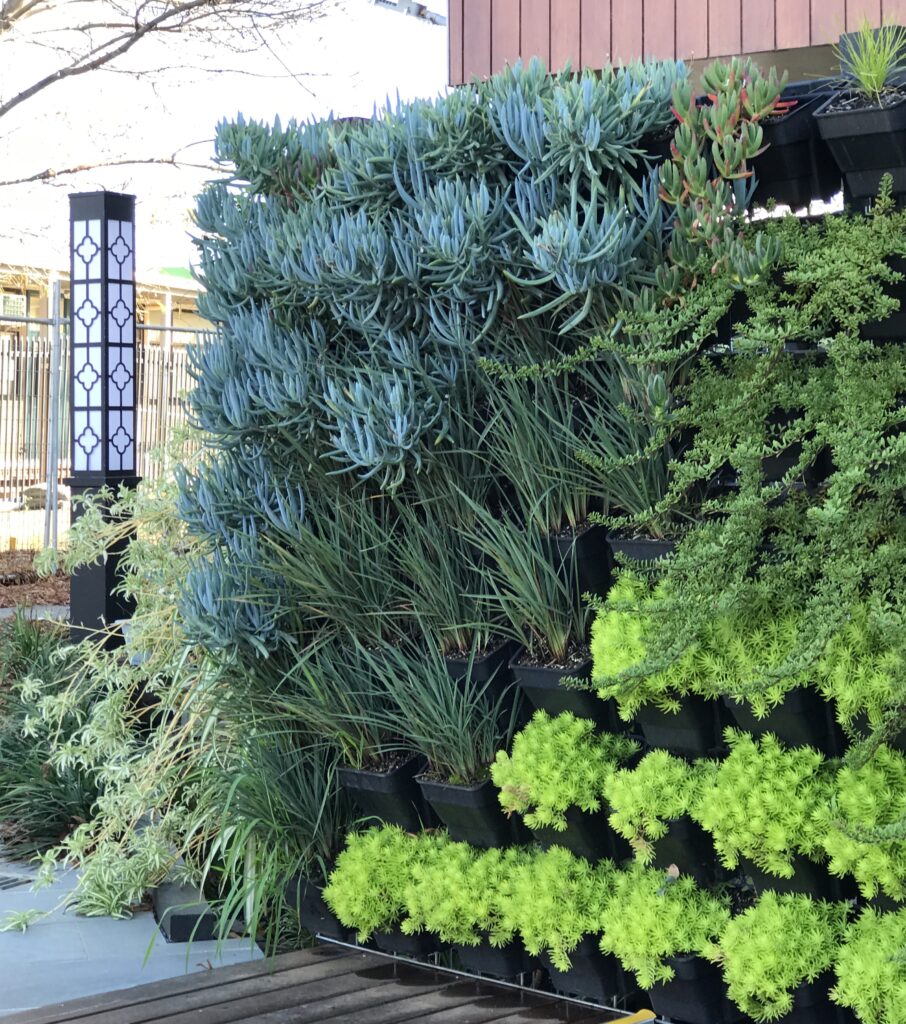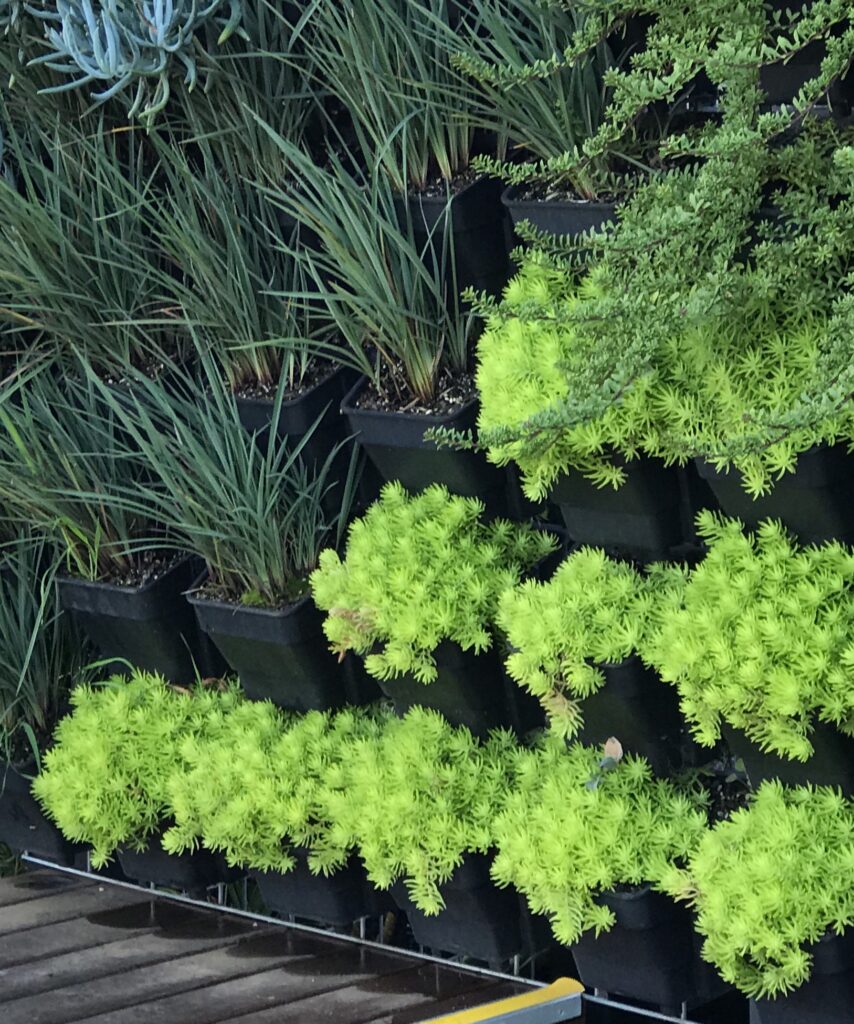
Up against the wall: Challenging traditional ideas of accessible gardens
Accessibility is one of the most important considerations for the meaningful participation of people with disability in gardening. There is a plethora of great garden design guides available for accessible gardening and many great innovations on the market to help make gardening accessible. But so far, one method of contained growing is largely underexplored and is quite literally staring us in the face – the vertical garden.
The most obvious way we make gardening accessible for people of varying abilities is typically to raise gardening beds to waist height, ensure safe access around them and create garden bed configurations that enable the user to reach and utilise all available growing spaces. Most raised beds eliminate the need to either bend, kneel or squat when tending to the garden. They also typically allow people who rely on a wheelchair or require support when walking or standing, to access garden beds more easily. Some beds even cleverly allow for wheelchairs to sit under the garden providing even closer interaction with plants.
‘The best benefit of a modular vertical garden is its ability to reflect a collective growing effort’
Vertical gardens provide a new perspective of the garden and therefore the way we interact with each plant within it. Issues of garden widths that obscure the sight or reach of plants are overcome by turning the footprint of a garden on its axis. Positioning vertical gardens within reachable heights make all plants equally accessible to users. The tipping of a garden on its axis also enables greater visibility of plants, each sitting in clear view on the growing plane and potentially making plant care and garden maintenance easier.
Accessible garden design prefers full access to all sides of garden beds, or particular bed dimensions that eliminate dead zones in gardens that cannot be reached. There are many different growing systems when it comes to vertical growing, and along with these, different advantages for accessibility. A modular vertical garden has the added benefit of enabling each planting container to be removed and safely tended to on any table or raised surface. This makes the garden particularly useful for occupational therapy and rehabilitation programs. Any plant within the vertical wall can be separately and safely removed eliminating issues with plants at the centre being difficult to reach or increasing risk of injury for the gardener attempting to reach them. With this growing system, plants can also easily be changed without disturbing neighbouring plants thus increasing the success of the overall garden.
Vertical gardens can also act as privacy screens, offering more intimate living areas for residents in care institutions whilst softening hard and often sterile walls that typically feature in such settings. Useful in courtyards or on balconies, they offer visual appeal and interest, acoustic softening, cooling effects and a sense of general tranquillity. Their relatively slimline profile means they take up less space than raised beds in small areas, avoids cluttering in small spaces, eliminates the need for added space to manoeuvre around them and can be custom designed to available vertical spaces for the perfect fit in both public and private settings.

Safe mobility around garden beds is another important consideration of accessible garden design, with paths kept clear from any obstructions and made from safe and level materials to reduce the risk of falls, tripping or impeding access. However, in the pursuit of accessibility there is often a reduction in the interactions we have with plants that bring added sensory enjoyment to our time in the garden. Plants growing beyond garden boundaries and across pathways are a readily identified hazard, but one that provides a wonderful opportunity to deliberately or incidentally bruise foliage and release wonderful aromas. Wide pathways make brushing against foliage and textural interactions less likely, which is somewhat of a shame as it limits our sensory enjoyment of the garden. Vertical gardens overcome this issue by allowing people to brush past foliage whilst still keeping the ground free from any infrastructure or hazards, ensuring safe passageway around the garden.
Perhaps the best benefit of a modular vertical garden though, is its ability to reflect a collective growing effort. In a shared accommodation site such as an aged care or disability service, each resident can become a custodian of one or more modular containers, which when joined together demonstrates the collective togetherness of the community residing there. Not only a beautiful display for all to enjoy, but a powerful statement of the retention of each resident’s individual identity, and their place and belonging within the community they collectively create and belong to.
There are many growing options available for a vertical accessible garden. Planting guides based on sensory experiences are readily available online and many of these work in vertical walls also. Keep in mind the need for hanging plants to stay off the ground to minimise tripping hazards.
Options for growing vertically include:
- Leafy edibles such as, mizuna, pak choy, lettuce, spinach, mustard, kale and silver beet for taste, texture and colour
- Scented plants such as basil, coriander, thyme, mints and lemon balm for a mixture of scents when brushed up against or bruised
- Flower colour such as marigolds, pansies, violas, impatiens etc., for seasonal colour dependent on environmental conditions on the property
- Shade loving plants that can add colour and texture and lighten up dark spaces such as Blechnum ferns, Maidenhair ferns, bromeliads, Spider plant, Hares foot fern
- Lower maintenance plants such as variegated ivy, Philodendron Xanadu, Sedums and Liriopes can add a mixture of colour and growing habit that can allow plants to intertwine to create a tapestry of plant varieties
Michael Casey is Director of Evergreen Infrastructure and MJC Horticulture, and National President of Australian Institute of Horticulture. Michael has been involved in the recent Road Map for green roofs, walls and facades in Australia’s urban landscape 2020-2030 and Skills Impact’s Green Walls & Rooftop Gardens Project. He can be contacted at president@aih.org.au or Michael@evergreeninfrastructure.com.au
Dr Kate Neale is a Research Fellow at the Centre for Children and Young People, Southern Cross University and the Centre for Urban Greenery and Ecology, Singapore National Parks Board. She specialises in the therapeutic benefits of horticulture for children, and people with disability. She is the Vice President of Therapeutic Horticulture Australia and a full member of the Australian Institute of Horticulture. Her work can be viewed at www.digability.com.au.
